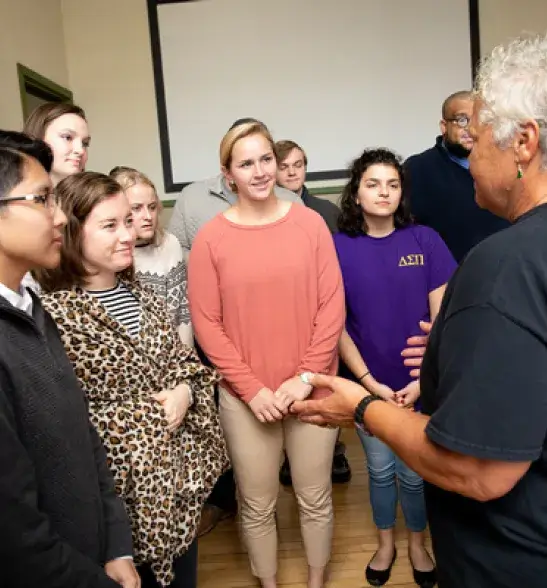Our Nation's Story
Sign up for our newsletterAn initiative to engage Americans in conversations that account for all aspects of our history and find common hopes for the future of our country.
At a time of increased division and polarization, Our Common Purpose invites Americans to commemorate the semiquincentennial in 2026 by both celebrating our nation’s accomplishments and reckoning with the shortcomings of the American story. The report recognizes that uncovering the stories and narratives that unite us and reckoning with those that divide us is an integral aspect of the practice of democratic citizenship.
In 2022, the Academy began convening national, state, and local organizations planning to commemorate the 250th anniversary of the Declaration of Independence. These organizations represent the arts, museums, libraries, local history agencies, state and jurisdictional humanities councils, and academic centers. These convenings sought to identify both the opportunities and challenges that the commemoration of the semiquincentennial presents.
The semiquincentennial represents an opportunity for Americans to engage with one another and share their aspirations for the future of our democracy. The following is a list of principles developed through the Academy’s convenings with civil society organizations. We hope that interested organizations and individuals can use these principles as a guide when planning for the semiquincentennial in 2026, regardless of whether they are responsible for public or private programming.
- Listen and Dialogue: We should shift our focus away from telling the American story to listening for the American story. Our shared national narratives should come from the bottom up, not the top down. The semiquincentennial is an opportunity for this kind of civic conversation. We should create spaces for discussion that allow participants to explore their thoughts and feelings about the nation’s story. These dialogues should bring community members together across lines of difference, including partisan divides. Community conversations can be used to help Americans from all walks of life hear one another’s understandings of the nation’s history and their hopes for our collective future.
- Include: Commemorating the Declaration’s ratification should be undertaken in an inclusive manner that branches beyond the traditional focus on Boston and Philadelphia. The semiquincentennial should include “all stories, all people, and all places.” We should think beyond city centers, engage communities in their local contexts, and even include opportunities for transatlantic collaboration.
- Reckon, Celebrate, and Imagine: The telling of American history itself has often been polarized, emphasizing only the good or only the bad of our nation’s story. The semiquincentennial should be used to create shared narratives about both the glory and the gory of the American past. We should celebrate our country’s achievements while also reckoning with mistakes and failures. Reckoning with mistakes and failures also requires adhering to curatorial best practices when presenting material or artifacts connected to histories of violence. With an honest understanding of where we have been, what we have achieved, and what we have yet to achieve as a country, we can create a clearer vision of what we imagine for the future of our constitutional democracy.
- Experiment: Those in and beyond the history profession should use the semiquincentennial to experiment with innovative ways to engage the public in conversations on history. We should embrace new formats and approaches to involve participants of all ages, stages of life, cultural, racial, economic, and experiential backgrounds who want to share in and explore the complex American experience.
The following resources have been developed to promote community conversations about the complex and always evolving American story. They include guides, toolkits, and funding resources that provide tactical next steps to prepare for commemorating the U.S. semiquincentennial.
-
The American Association for State and Local History’s field guide offers guiding themes, ideas, goals, and information for the history community.
-
Field Guides for Commemorating the 250th Anniversary of the United States:
-
The National Park Service provides resources for how to teach and learn about historic places.
-
Wilkening Consultants conducted a survey on Americans’ views of the 250th. Here are their Key Findings & Data Story.
-
The “10 Questions for Young Changemakers” was developed by the Massachusetts Library System as a resource for civic education in the digital age which aims to help young people achieve successful, equitable, and effective participation in a new media environment.
-
More in Common’s research findings from Defusing the History War: Finding Common Ground in Teaching America’s National Story illustrate how Americans are not as divided over their history and national identity as one might believe. There is a lot of common ground across the partisan divide about acknowledging historical failures and celebrating American achievements.
-
The Kettering Foundation’s Historic Decisions: Looking Deliberatively at the Past support critical deliberations about historical problems. They provide educators with tools to use in the classroom to foster critical thinking about historical topics.
To learn more about this initiative, please contact Kelsey Ensign.

To coincide with the 250th anniversary of the Declaration of Independence, create a Telling Our Nation’s Story initiative to engage communities throughout the country in direct, open-ended, and inclusive conversations about the complex and always evolving American story. . . .
